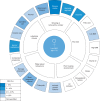Reducing low birth weight: prioritizing action to address modifiable risk factors
- PMID: 26888979
- PMCID: PMC5409066
- DOI: 10.1093/pubmed/fdv212
Reducing low birth weight: prioritizing action to address modifiable risk factors
Abstract
Background: Low birth weight (LBW) affects 6.9% of all UK births and has remained largely unchanged for many years. The United Nations and the World Health Assembly have set targets to substantially reduce global incidence. Understanding the contribution of modifiable risk factors to the burden of LBW is required to ensure appropriate interventions are in place to achieve this reduction.
Methods: Data from published studies on the risks from key modifiable factors were used alongside prevalence data from the Welsh population to calculate the population attributable risk for each factor individually and in combination.
Results: Fourteen risk factors accounted for nearly half of LBW births, and 60% of those to younger mothers (<25 years). Tobacco smoke exposure was the largest contributor. We estimated that smoking in pregnancy was a factor in one in eight LBW births, increasing to one in five for women aged under 25.
Conclusions: Risk factors are interrelated and inequitably distributed within the population. Exposure to one factor increases the likelihood of exposure to a constellation of factors further increasing risk. Action to address LBW must consider groups where the risk factors are most prevalent and address these risk factors together using multi-component interventions.
Keywords: low birth weight; modifiable risk factors; population attributable risk; pregnancy; tobacco.
© The Author 2016. Published by Oxford University Press on behalf of Faculty of Public Health.
Figures
Similar articles
-
Utility of Population Attributable Fraction Assessment in Guiding Interventions to Reduce Low Birthweight in the High-Altitude State of Colorado.Matern Child Health J. 2016 Dec;20(12):2457-2464. doi: 10.1007/s10995-016-2037-6. Matern Child Health J. 2016. PMID: 27334635
-
Low birthweight, preterm births and intrauterine growth retardation in relation to maternal smoking.Paediatr Perinat Epidemiol. 1997 Apr;11(2):140-51. doi: 10.1046/j.1365-3016.1997.d01-17.x. Paediatr Perinat Epidemiol. 1997. PMID: 9131707
-
Modifiable risk factors for low birth weight and their effect on cerebral palsy and mental retardation.Matern Child Health J. 2007 Jan;11(1):65-71. doi: 10.1007/s10995-006-0085-z. Matern Child Health J. 2007. PMID: 16802187
-
Folic acid supplementation and malaria susceptibility and severity among people taking antifolate antimalarial drugs in endemic areas.Cochrane Database Syst Rev. 2022 Feb 1;2(2022):CD014217. doi: 10.1002/14651858.CD014217. Cochrane Database Syst Rev. 2022. PMID: 36321557 Free PMC article.
-
Interventions for the control of diarrhoeal diseases among young children: prevention of low birth weight.Bull World Health Organ. 1985;63(1):165-84. Bull World Health Organ. 1985. PMID: 3886185 Free PMC article. Review.
Cited by
-
Causal Association Between Birth Weight and Adult Diseases: Evidence From a Mendelian Randomization Analysis.Front Genet. 2019 Jul 10;10:618. doi: 10.3389/fgene.2019.00618. eCollection 2019. Front Genet. 2019. PMID: 31354785 Free PMC article.
-
A Population-based Prospective Study to Identify Contributors to Mother and Child Health in Suburban Communities: The Cohort Profile.Iran J Public Health. 2018 Mar;47(3):441-448. Iran J Public Health. 2018. PMID: 29845034 Free PMC article.
-
Specification of Change Mechanisms in Pregnant Smokers for Malleable Target Identification: A Novel Approach to a Tenacious Public Health Problem.Front Public Health. 2017 Sep 19;5:239. doi: 10.3389/fpubh.2017.00239. eCollection 2017. Front Public Health. 2017. PMID: 28975128 Free PMC article.
-
Asthma and/or hay fever as predictors of fertility/impaired fecundity in U.S. women: National Survey of Family Growth.Sci Rep. 2019 Dec 10;9(1):18711. doi: 10.1038/s41598-019-55259-8. Sci Rep. 2019. PMID: 31822754 Free PMC article.
-
Smoking and Smoking Cessation in the Risk for Fetal Growth Restriction and Low Birth Weight and Additive Effect of Maternal Obesity.J Clin Med. 2020 Oct 29;9(11):3504. doi: 10.3390/jcm9113504. J Clin Med. 2020. PMID: 33138256 Free PMC article.
References
-
- OECD. Infant Health: Low Birth Weight. In Health at A Glance: Europe 2012. Paris: OECD Publishing, 2012.
-
- Ohlsson A, Shah P. Determinants and Prevention of Low Birth Weight: A Synopisis of the Evidence. Alberta, Canada: Institute of Health Economics, 2008.
-
- Breslau N, Paneth NS, Lucia VC. The lingering academic deficits of low birth weight children. Pediatrics 2004;114(4):1035–40. - PubMed
-
- UNICEF and World Health Organisation. Low Birthweight: Country, Regional and Global Estimates. New York: UNICEF, 2004.
-
- WHO. Global Nutrition Targets 2025: Low Birth Weight Policy Brief. Geneva: World Health Organisation, 2014.
MeSH terms
Grants and funding
LinkOut - more resources
Full Text Sources
Other Literature Sources



